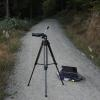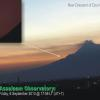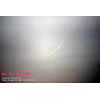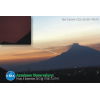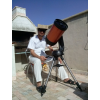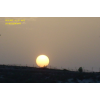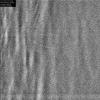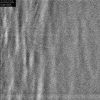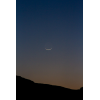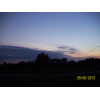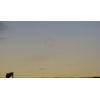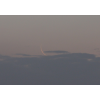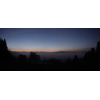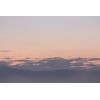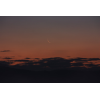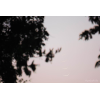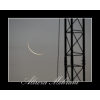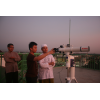Visibility of Dhul Qeadah Crescent 1434 AH
- When to Observe Dhul Qeadah Waxing (NEW) Crescent ?
- Dhul Qeadah Waxing (NEW) Crescent Observation Results
- The OFFICIAL First Day in Different Countries
- When to Observe Shawwal Waning (OLD) Crescent ?
- Shawwal Waning (OLD) Crescent Observation Results
When to Observe Dhul Qeadah Waxing (NEW) Crescent ?
The geocentric conjunction (Geocentric New Moon) will occur Inshalla on (Thursday 05 September 2013) at 11:36 UT.
Sighting the new crescent on (Thursday 05 September 2013) and (Friday 06 September 2013) is shown in the below graphs using the program Accurate Times by Mohammad Odeh according to Odeh criterion. Where:-
- It is impossible to see the crescent from the areas located under the red color. Because either the Moon on this day sets before the Sunset and/or the topocentric conjunction occurs after the Sunset.
- The crescent is expected to be seen by optical aid only from the areas located under the blue color.
- The crescent is expected to be seen by optical aid from the areas located under the magenta color. In these areas the crescent could be seen by naked eye if the atmospheric conditions are superb and the observer is experienced.
- The crescent is expected to be easily visible by naked eye from the areas located under the green color.
- The crescent cannot be seen from uncolored areas, even though the Moon sets in these locations after the Sunset and the topocentric conjunction occurs before the Sunset, but the Moon is not sufficiently illuminated in order to be seen as crescent even by optical aid.
- Kindly notice that the below graph shows the possibility of seeing the crescent from areas between 60 degrees north of Equator down to 60 degrees south of Equator.

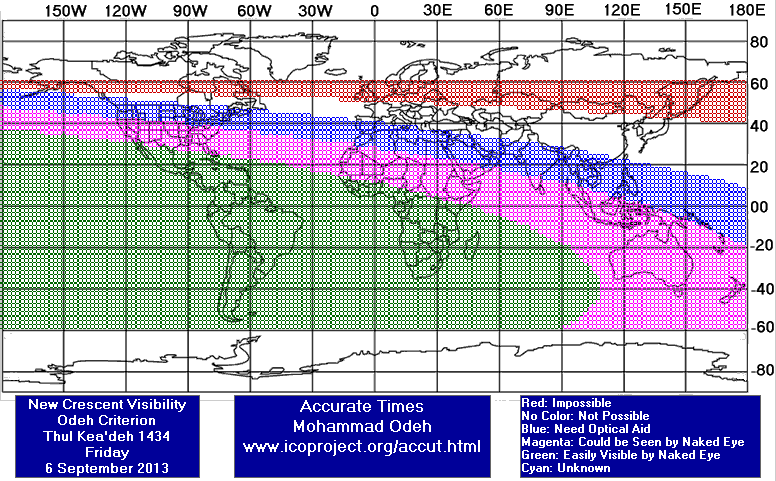
According to the Universal Hejric Calendar (UHC), which is based on the calculated crescent visibility, the start of this month in the Eastern Region will be on Saturday 07 September 2013 and in the Western Region will be on Saturday 07 September 2013. Kindly notice that the UHC is a pre-calculated calendar, which adopts a certain criterion to start the new Hejric month. Your country/organization might adopt different criterion to start the new Hejric month. So it is highly advised to read the UHC website before giving any judgment.
- Results of seeing the crescent, and the first day of the month in different countries will be added here Inshalla as we receive the reports from ICOP's members. If you wish to be a member in ICOP, or to know more about it, kindly click here.
Dhul Qeadah Waxing (NEW) Crescent Observation Results
Fri 06 September 2013
Algeria
Germany
Eng. Martin Elsaesser said: " I tried to observe the very difficult evening crescent of 6. September from a local ridge at about 1100m. The view to the west was clear but some far away contrails would later cause trouble. The crescent was wide at 15° elongation but lag time was only 2 minutes so this would be very interesting. After hiking for 30minutes from the nearest parking space i found that the camera i wanted to use could not be mounted on the new tripod, so i had to use a less powerful backup camera. I also could not cary a tracking mount with telescope to that place so i only had a small foto-lens with the camera and the special imaging software. I searched for 15 minutes until i had located the crescent and could then follow it until the sun disappeared in the low clouds, which were actually contrails from planes many more than 200km away. But as i was almost 1000m above the lowlands in the west the sun and moon were visible very low and when i lost the moon in the same clouds it was at about 0° elevation. So this was almost but not quite an observation after sunset. The crescent can only be seen in the video of the event. It can be viewed here: http://www.youtube.com/watch?v=62gaEdGFqI8 With a tracking mount and the other camera the images would have been much clearer. "
Ghana
Mr. Abdul-Aziz Anyang said: "Hilal (new crescent) is not expected to be seen with the known astronomical details."
Indonesia
Mr. AR Sugeng Riyadi said: "Al-hamdulillah, on Friday 6 Sept 2013, we are able to sight the new crescent of Thul Keadah 1434 AH from Assalaam Observatory, Pabelan Kartasura Sukoharjo - Surakarta, central Java Indonesia. We are about 60 persons, from CASA (Assalaam Students Astronomy Club), and MuslimDaily.Net. Only one student of CASA could see by naked eye, he was Tri Wahyu Adji (2nd class of Assalaam SHS). The others had observe via DSLR screen connected to Telescope. Timelapse video is here: http://www.youtube.com/watch?v=ZGxVh8hrm0g"
Iran
Eng. Seyyed Ghasem Rostami said: "I saw the crescent by 8" telescope in day time from 13:10 to 16:30. Comment from ICOP Management. This crescent was seen by telescope before Sunset."
Libya
Malaysia
Mr. Firdaus Mazlan said: "On Friday, 6 th September 2013 M equal to 29 th Syawwal 1434 H, I with my friends (Mr. Mohammad Hasbarizal bin Hasan, Mr. Muhammad Zainal Abiden bin Mohamad Hani, and Mr. Ahmad Sufian) cannot see the new moon either with telescope, or binocular or naked eye at Pantai Klebang, Melaka (02° 15' N , 102° 15' E). It because the horizon is very cloudy. Our government have announced that tomorrow (Saturday - 7/9/2013 M) is the first Dhul-Qi'dah 1434 H. "
Nigeria
Dr. Z.Sani Mustapha said: "New crescent begins after sunset and not at fajr. If it were to be at fajr time, then there is no sense in observing it after sunset. Let the Indian scholars please read Nathrul Waruud ala marraqii Sauud by Shankiti. "
Oman
Prof. Mohammed Al-Bussaidi said: "The sky was very hazy and cloudy. However, 20 minutes before sunset the clouds a little bit thinned down thus allowing us to do observations. We were able to capture through our CCD camera a crescent Moon, this lasted for about 17 minutes but again very thick clouds closed the door for our observations."
Saudi Arabia
South Africa
Dr. Abdurrazak Ebrahim said: "Friday, 06 September 2013 and the end of the 29th Shawwaal Dhul Qada 1434 AH Hilaal first sighted by naked-eye at 18h50, 18 minutes after apparent sunset. Hilaal observed from my home in the Zeekoevlei Nature Reserve, Cape Town. Sunset: 18:32 LT Moonset: 19:41 LT Moon-age: +28h 01m Moon longitude: +177°:48':06" Moon latitude: -03°:07':51" Moon altitude: +09°:09':13" Moon azimuth: +273°:46':54" Relative altitude: +13°:53':27" Elongation: +13°:54':00" Crescent width: 27 arc seconds Illumination: 01.47 % Magnitude: -05.37 Distance: 388 006.95 km "
Sri Lanka
Mr. Nular Bary said: " Assalamualaikum W.R.W.B.
Today 29th. of Shawwal 1434H (6/09/2013) rainy evening in Colombo,I tried to see the Hilal of Dhul-Qi'dah even with my binocular I couldn't trace a thing, Our moonset was at 6;50pm. & Sunset was at 6;16pm.and the Moon age was 26h.10m.at the time of Sunset,and no positive sighting was reported to the Hilal committee of Sri Lanka who assembled at the Colombo Grand Mosque.Hence the committee decided to complete the month of Shawwal with 30days and start the month of Dhu-Qi-dah on Sunday the 8th. of September 2013."In Sha Allah"
The Colombo Grand Mosque, All Ceylon Jemmiyathul Ulemah and various Islamic Organization in Sri Lanka will hold a meeting on 8th. September 2013. to deliberate and decide on an acceptable National Policy on Islamic Calendar and put an end to the confusion face by Muslims here in Sri Lanka.
" Tunisia
United Kingdom
Eng. Qamar Uddin said: "On Friday 6 September 2013 (29 Shawwal 1434 AH) many people from throughout the UK have attempted to sight the crescent moon (Hilal) of Dhul Qaidah after sunset. None of the groups were able to sight the Hilal as many places had cloudy sky conditions. However, we have received a reliable sighting report (Muhaqaq-Ruyat-Basari) from Jamiat-e-Ulama South Africa of positive sightings. Therefore, the Wifaqul Ulama have decided that the month of Shawwal 1434 AH will have 29-days and the month of Dhul Qaidah 1434 AH will start from Saturday 7 September 2013, Insha-Allah. "
United States
Dr. Javad Torabinejad said: "My daughter and I arrived at our sighting location (The Blacksburg Middle School) at 7:47 pm EDT (sunset: 7:42 pm). Using binoculars (10X50 and 7X50), we scanned the western horizon with no success. The lower part of the horizon was cloudy. While Venus was easily seen by naked eye, Mercury was not visible even through the binoculars. We left the site after moonset (moonset: 8:09 pm)."
The OFFICIAL First Day in Different Countries
Fri 06 September 2013
1 . Nigeria
Sat 07 September 2013
1 . Algeria
2 . Ghana
3 . Indonesia
4 . Iran
5 . Libya
6 . Malaysia
7 . Oman
8 . South Africa
9 . Tunisia
10 . United Kingdom
Sun 08 September 2013
1 . Sri Lanka
When to Observe Shawwal Waning (OLD) Crescent ?
The geocentric conjunction (Geocentric New Moon) will occur Inshalla on (Thursday 05 September 2013) at 11:36 UT.
Sighting the OLD crescent on (Thursday 05 September 2013) and on (Wednesday 04 September 2013) is shown in the below graphs using the program Accurate Times by Mohammad Odeh according to Odeh criterion. Where:-
- It is impossible to see the OLD crescent from the areas located under the red color. Because either the Moon on this day rises after the Sunrise and/or the topocentric conjunction occurs before the Sunrise.
- The crescent is expected to be seen by optical aid only from the areas located under the blue color.
- The crescent is expected to be seen by optical aid from the areas located under the magenta color.. In these areas the crescent could be seen by naked eye if the atmospheric conditions are superb and the observer is experienced.
- The crescent is expected to be easily visible by naked eye from the areas located under the green color.
- The crescent cannot be seen from uncolored areas, even though the Moon rises in these locations before the Sunrise and the topocentric conjunction occurs after the Sunrise, but the Moon is not sufficiently illuminated in order to be seen as crescent even by optical aid.
- Kindly notice that the below graph shows the possibility of seeing the crescent from areas between 60 degrees north of Equator down to 60 degrees south of Equator.
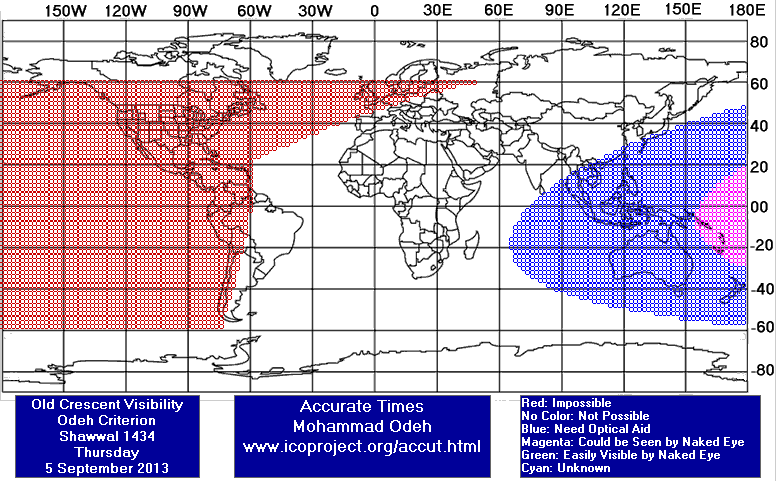
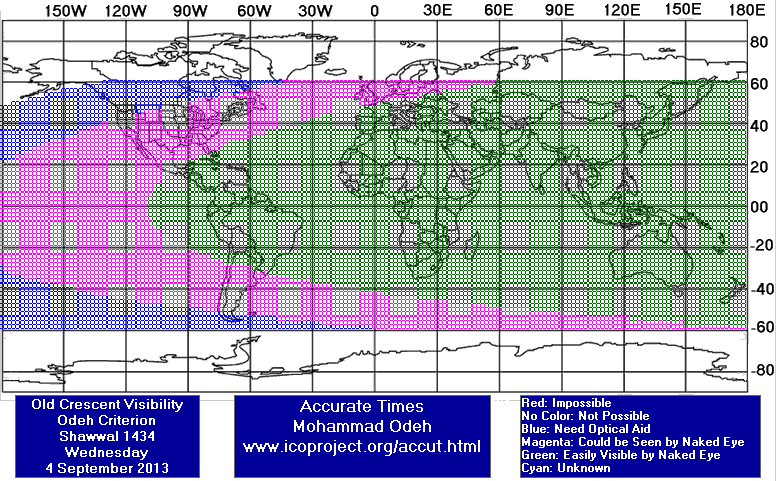
Shawwal Waning (OLD) Crescent Observation Results
Wed 04 September 2013
Algeria
Germany
Eng. Martin Elsaesser said: "I observed the morning crescent of 4. September during my holidays. The sky was clear but there was a lot of fog in the valeys and i was just barely above the fog at 650m, so i frequently had clouds of fog obscuring the view. Still, the crescent could be seen with the naked eye and more easily with a pair of binoculars. I have attached a pair of images showing a faint view of the crescent (as it appeared in binoculars) and a second version with some contrast enhancement from the same image data."
Indonesia
Mr. AR Sugeng Riyadi said: "Alhamdulillah, on Wednesday, 04 September 2013 the old crescent of Shawwal 1434 Ah was very easy SEEN from my Personal Observatory, Bendo - Ketitang - Juwiring - Klaten - Central Java - Indonesia. I had just observed the moon with my youngest son (Ahmad Darus Salam Ainur Rosyad)."
Iran
Thu 05 September 2013
Indonesia
Mr. AR Sugeng Riyadi said: "On Thursday, 05 September 2013 the old crescent of Shawwal 1434 AH was NOT SEEN from Assalaam Observatory, Sukoharjo-Surakarta Central Java Indonesia. We are about 30 person from CASA (Club Astronomi Santri Assalaam) male and female students. The were leaded by mr. Muflih Arisa Adnan from RHI Surakarta and Ustadz Drs. H. M. Rohimulloh, M.Pd. as the head of Astronomy Laboratory."
Nigeria
Dr. Z.Sani Mustapha said: "It has been generally cloudy throughout the month."
